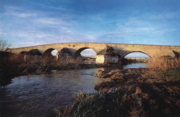
Ofanto
Encyclopedia
The Ofanto, known in ancient times as Aufidus, from the Greek
Ophidus, Ωφιδους, meaning snake, is a 170 km river
in southern Italy
. which flows through the regions of Campania
, Basilicata
and Puglia, and into the Adriatic Sea
near Barletta
.
near Canosa di Puglia there is an ancient Roman bridge known all over the south of Italy.

Plateau to 715 m above sea level, below the plane of the Angel, near Avellino
. Throughout parts of Campania
and Basilicata
, then rolling mainly in Puglia. Flows into the Adriatic Sea
, near Barletta
. At the end of its course, the Ofanto ends with a mouth on the delta, although rapid retreat to an estuary. The Ofanto has a torrential regime markedly with major floods in autumn and winter rainfall in summer and low flows remarkable. In spite then of considerable length and extent of its basin average flow at the mouth is quite low (less than 15 cubic meters per second)
Greek language
Greek is an independent branch of the Indo-European family of languages. Native to the southern Balkans, it has the longest documented history of any Indo-European language, spanning 34 centuries of written records. Its writing system has been the Greek alphabet for the majority of its history;...
Ophidus, Ωφιδους, meaning snake, is a 170 km river
River
A river is a natural watercourse, usually freshwater, flowing towards an ocean, a lake, a sea, or another river. In a few cases, a river simply flows into the ground or dries up completely before reaching another body of water. Small rivers may also be called by several other names, including...
in southern Italy
Italy
Italy , officially the Italian Republic languages]] under the European Charter for Regional or Minority Languages. In each of these, Italy's official name is as follows:;;;;;;;;), is a unitary parliamentary republic in South-Central Europe. To the north it borders France, Switzerland, Austria and...
. which flows through the regions of Campania
Campania
Campania is a region in southern Italy. The region has a population of around 5.8 million people, making it the second-most-populous region of Italy; its total area of 13,590 km² makes it the most densely populated region in the country...
, Basilicata
Basilicata
Basilicata , also known as Lucania, is a region in the south of Italy, bordering on Campania to the west, Apulia to the north and east, and Calabria to the south, having one short southwestern coastline on the Tyrrhenian Sea between Campania in the northwest and Calabria in the southwest, and a...
and Puglia, and into the Adriatic Sea
Adriatic Sea
The Adriatic Sea is a body of water separating the Italian Peninsula from the Balkan peninsula, and the system of the Apennine Mountains from that of the Dinaric Alps and adjacent ranges...
near Barletta
Barletta
Barletta is a city and comune located in the north of Apulia in south eastern Italy. Its current population is 94,140.It is famous for the Colossus of Barletta, a bronze statue, representing a Roman Emperor...
.
near Canosa di Puglia there is an ancient Roman bridge known all over the south of Italy.

length of the river
Its source is IrpiniaIrpinia
Irpinia is a region of the Apennine Mountains around Avellino, a town in Campania, South Italy about 40 km east of Naples...
Plateau to 715 m above sea level, below the plane of the Angel, near Avellino
Avellino
Avellino is a town and comune, capital of the province of Avellino in the Campania region of southern Italy. It is situated in a plain surrounded by mountains 42 km north-east of Naples and is an important hub on the road from Salerno to Benevento.-History:Before the Roman conquest, the...
. Throughout parts of Campania
Campania
Campania is a region in southern Italy. The region has a population of around 5.8 million people, making it the second-most-populous region of Italy; its total area of 13,590 km² makes it the most densely populated region in the country...
and Basilicata
Basilicata
Basilicata , also known as Lucania, is a region in the south of Italy, bordering on Campania to the west, Apulia to the north and east, and Calabria to the south, having one short southwestern coastline on the Tyrrhenian Sea between Campania in the northwest and Calabria in the southwest, and a...
, then rolling mainly in Puglia. Flows into the Adriatic Sea
Adriatic Sea
The Adriatic Sea is a body of water separating the Italian Peninsula from the Balkan peninsula, and the system of the Apennine Mountains from that of the Dinaric Alps and adjacent ranges...
, near Barletta
Barletta
Barletta is a city and comune located in the north of Apulia in south eastern Italy. Its current population is 94,140.It is famous for the Colossus of Barletta, a bronze statue, representing a Roman Emperor...
. At the end of its course, the Ofanto ends with a mouth on the delta, although rapid retreat to an estuary. The Ofanto has a torrential regime markedly with major floods in autumn and winter rainfall in summer and low flows remarkable. In spite then of considerable length and extent of its basin average flow at the mouth is quite low (less than 15 cubic meters per second)

